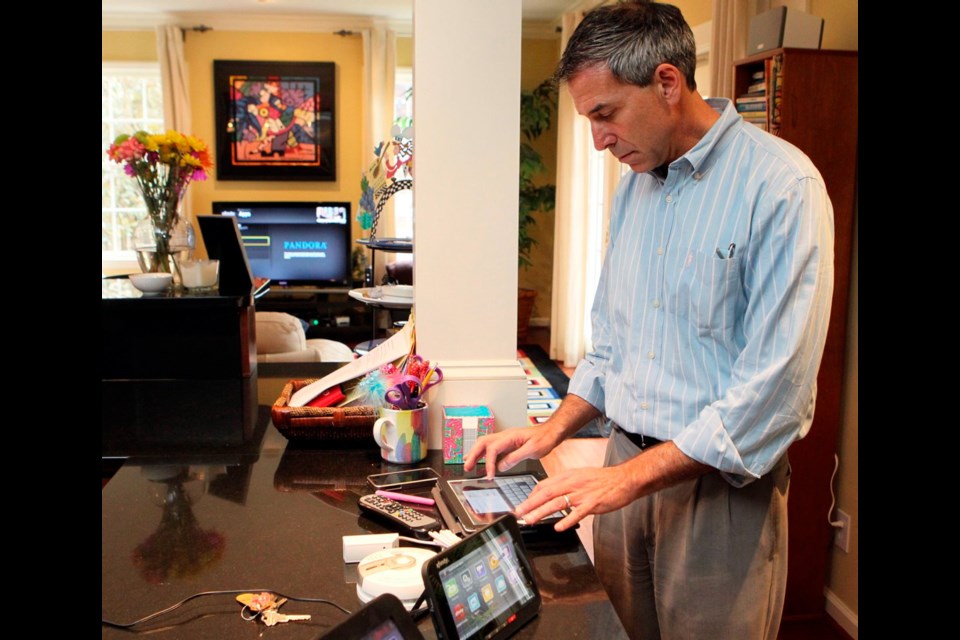ATLANTA — Every day, Larry Schweber can see his eight-year-old daughter come home from school, even while he’s at work. He gets a text message with a video clip every time someone walks through the front door of his home.
The thermostats on the first floor of that home start to raise the temperature automatically at 5:30 a.m. every day and then lower it at 8:30 a.m., once everyone has left the house. The thermostats adjust again when Lily Schweber comes home after school, and at night they switch to warm the bedrooms upstairs while the family is sleeping.
Welcome to the “connected home,” the new way of managing your home’s security system, lights, temperature and entertainment systems. By using an app on a smartphone or tablet, people can turn lights on and off, let in a delivery person or see whether their kids are doing their homework — from anywhere in the world.
Programmable sensors and cameras help monitor movement, detect rising carbon monoxide levels and signal if there’s rising water, so consumers know about possible burglaries, water leaks and other emergencies immediately. Companies are touting peace of mind as well as lower insurance and utility bills because of the extra layers of security and energy management.
AT&T Mobility developed its Digital Life system in Atlanta and has been testing the system there and in Dallas. The wireless company will start selling the packages in those cities and six other markets next month. The company is pushing the concept of having everything in your home remotely accessible from anywhere at any time, CEO Ralph de la Vega said.
“This way you know if the coffee pot is off, the garage doors are down and what the weather is like” no matter where you are, de la Vega said.
For companies like AT&T Mobility and Comcast, already giants in the telecommunications industry, pushing into home automation is one way to expand their services and raise the competitive stakes.
AT&T is selling its package to any consumer, regardless of his or her wireless provider, giving the company the widest market options available.
Customers of Comcast’s XFinity Home system must also have the company’s broadband Internet. But Comcast’s connected systems offer wider entertainment options that include Facebook and Pandora apps for your TV and the ability to download movies and TV shows and watch them on a smartphone or tablet.
“It’s about taking your services with you or being at your house when you can’t be,” said Charlie Herrin, Comcast’s senior vice president of product design.
Home automation has been around for years, but the systems used to cost thousands of dollars, making them affordable only for the richest homeowners. Changes in technology and the ability to control the systems using smartphones and tablets have helped bring down the price and make them more widely available.
Home automation will grow slowly at first, said Roger Entner, a telecommunications analyst with Boston-based Recon Analytics. But, he said, once you’ve seen it, “you’re thinking, ‘I can use that, and it’s not that expensive.’ ”
The systems — typically a package of cameras, sensors and other devices — range from $200 to $400 to buy, but can cost more, depending on additional features. Service fees can start as low as $30 a month for some basic packages but can run to more than $100 for premium services.
“The moment that the savings are showing [on insurance and utility bills], that’s when this really becomes a no-brainer,” Entner said.
Insurance companies offer discounts for additional home-monitoring systems. The amount customers save depends on the type of monitoring service and features that are included, an Allstate spokesman said. Users of traditional home-security systems are slow to add the “connected features,” said Jim Callahan, CEO of Atlanta’s Ackerman Security, which has switched its systems from traditional wires and landline phones to a wireless one that can be controlled by remote.
About 25 per cent to 30 per cent of new customers want the additional thermostat-monitoring systems, remote lock devices and cameras.
“Not everybody we’re talking to is clamoring for it,” he said.
Still, he said, Ackerman installed about 350 connected systems last month.
Analysts say it’s too early to have widespread reports of security breaches, which consumers say are a top concern as things become more wireless. Each of the providers has customers type in a log-in, passcode and sometimes a PIN number to access their information — making it difficult for someone else to do so in the event a smartphone or tablet gets lost or stolen.
For now, the reports from users of the systems are good.
An AT&T Mobility employee testing the Digital Life system at his home helped Atlanta police nab a thief who was taking UPS and FedEx packages from neighbourhood porches last December, de la Vega said.
The employee aimed a sensor at the front doorstep and programmed it to send a text message every time there was motion. The employee then left a fake package in front of his house, and at 6 a.m. his phone lit up with a text message and photo of someone swiping the package.
One phone call to the police, and the thief was picked up 30 minutes later, de la Vega said.
“He took a system and was able to change it to work for him. It was that easy to program from an iPad,” de la Vega said.
Other uses include parents of teenagers programming sensors to detect when the liquor cabinet is opened, and water-level sensors that detect and warn of leaks in kitchen or laundry appliances.



